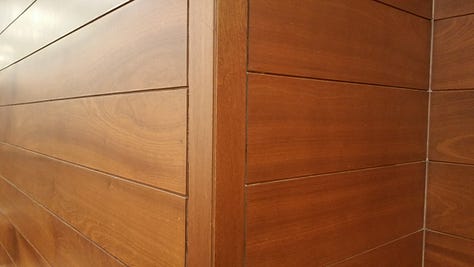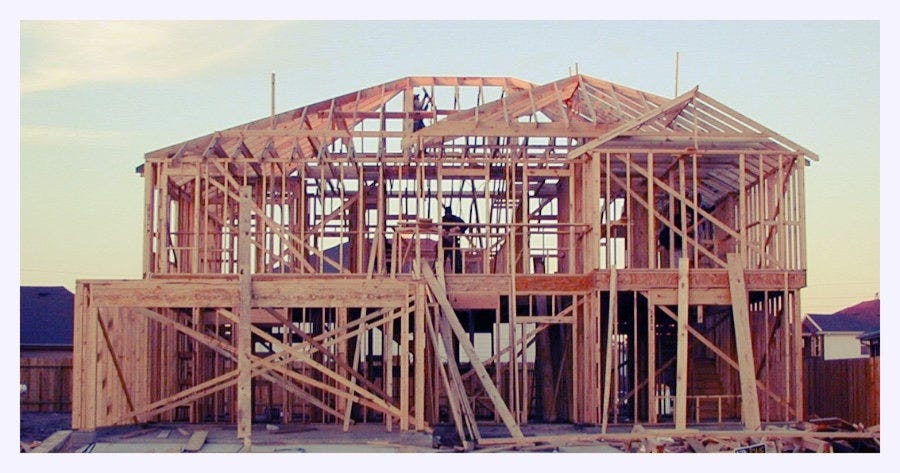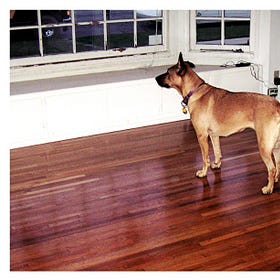This is a followup post to Battle of the Boards. The choice of whether to use a hardwood like oak or softwood like pine isn't always as clear cut. So, which wood should you use for your next project?
When it comes to construction, the choice of building materials can impact longevity, functionality, and aesthetics. Wood is a timeless favorite but not all timber is the same. Hardwoods and softwoods possesses unique characteristics, making each ideal for differing construction applications.
Framing
Softwoods are commonly used for structural framing, including wall studs, roof trusses, and floor joists. They are readily available, cost-effective, and provide adequate structural strength. Hardwoods are not typically used for framing nowadays.
Common hardwoods: oak, maple, hickory or ash.
Common softwoods: pine, spruce, fir and cedar
Softwoods
Softwood is not as dense or as hard as hardwood, but it still possesses sufficient strength to bear the weight of walls, roofs, and floors
Easier to cut, shape, and nail, which makes it a more practical choice
Straight and uniform grains result in straight, stable framing members
Flooring
Both hardwood and softwood are used as flooring materials.
Common hardwoods: oak, maple, cherry, walnut, mahogany, hickory and ash
Common softwoods: pine, douglas fir, cedar, and hemlock
Less common softwoods: cypress, larch and spruce
Hardwoods
Hardwoods, such as oak, maple, and walnut, are a popular choice for flooring because of their durability and attractiveness. Wood floors are available as solid hardwood planks or engineered hardwood which offers greater stability for varying humidity levels.
Resistant to wear and tear, making it ideal for high-traffic areas
Available in a wide variety of colors, grain patterns, and finishes, making it easier to match your decor; it is also easier to stain
Is relatively easy to clean and maintain, and it is more stain-resistant
Unlike engineered woods and softwoods, they can sanded and refinished multiple times, making it a more cost-effective long-term choice






Softwoods
Softwoods are generally less durable and more prone to wear and damage, but more budget-friendly option for flooring, especially if you're working with a tight budget.
More likely to scratch, dent, and show wear and tear over time
Easier to install but maintenance is more effort
Often have a more rustic appearance due to their pronounced grain patterns and color variations
Considered sustainable as it frequently comes from managed forests, and there are numerous reclaimed options available
More prone to warping, cupping, and shrinking when exposed to changes in humidity and temperature, which can lead to structural issues over time
Staining softwood can be challenging, potentially resulting in unevenness






Cabinetry
Hardwood is a popular choice for cabinetry due to its durability and attractive appearance. While less common than hardwood, some softwoods can be used for cabinetry.
Common hardwoods: oak, maple, cherry and birch
Common softwoods: pine, cedar, fir and redwood
Hardwoods
Hardwoods are the preferred choice for cabinetry due to their strength, fine grain patterns, and ability to take stains and finishes well. They can also provide a polished and elegant look to kitchen and bathroom cabinets.
Harder and heavier to work with
Preferable for cabinets that will get a lot of use
Provide better moisture resistance, making them more suitable for kitchens and bathrooms
Available in a wide range of colors, from light to dark, to complement different aesthetics
Feature a fine, tight grain that provides an attractive look
Accept a variety of finishes, including stains and paints
Suited for intricate woodworking and custom cabinetry projects
Softwoods
Some softwoods, like pine or cedar, are commonly used for cabinetry due to their attractive appearance and workability. They are lighter and easy to stain and paint. They are a budget conscious and eco-friendly option.
Decking
Hardwoods especially some of the imported hardwoods are highly resistant to weathering, insects, and decay, making them ideal for outdoor applications. Softwoods are less commonly used but some like cedar and redwood are insect resistant and others like pine can be pressure-treated to be more resistant.
Common Hardwoods: cumaru (Brazilian teak), garapa, ipe (Brazilian walnut), mahogany, tiger wood, batu, massaranduba and angelim pedra.
Common softwoods: cedar, pine (pressure treated), redwood, fir, and juniper
Hardwoods
Withstand the elements, including rain, snow, and UV radiation, without deteriorating as quickly
Low maintenance and don’t need chemical treatments
Have natural oils and resins that make them resistant to rot and decay
Tend to have a higher resistance to fire
Longer lifespan than softwood decks
Softwoods
Comes in lighter color and grain patterns that may be preferable
Easy to install






Doors
Both hardwood and softwood can be used for doors, depending on the specific requirements and preferences of the project. Hardwoods, with their attractive patterns, are popular for interior doors, especially in high-end or custom applications. Softwood doors can be lighter in weight, easier to work with, and more affordable. Additionally, doors often use plywood cores for stability, to reduce warping, and to achieve a lighter weight.
Common hardwoods: oak, maple, cherry, walnut, mahogany, hickory and ash
Common softwoods: pine, fir, cedar, redwood and hemlock
Hardwoods
Used for exterior doors to withstand weather, temperature fluctuations, and potential impact.
Ideal for creating elegant or luxurious interiors.
Preferred for projects involving intricate carvings, unique shapes, or complex designs.
Frequently used in preservation or restoration projects where styles need to be matched.
Appropriate for applications where sound insulation is desirable
When longevity is a priority, as doors can last for decades
Softwoods
Easier to cut, shape, and install
Provides a smoother surface for paint
Trim and molding
Hardwoods are commonly used for trim and molding due to their fine grain and ability to take intricate details. Poplar while not as hard as other hardwoods is often chosen for its affordability and ease of painting.
Common hardwoods: poplar, cherry, oak, maple and walnut
Common softwoods: pine (clear and knotty), fir, spruce and cedar
Hardwoods
Used when a specific grain pattern or aesthetic is desired
Preferred for high-traffic areas
Better for staining and finishing
Known for their longevity
Softwoods
Easier to cut, shape, and install
When painting vs. staining, softwoods provide a smoother surface for paint


Sheathing
Sheathing
Sheathing provides structural support to the exterior of a building or structure, such as the walls or roof. Sheathing materials can be made from various substances, including wood, oriented strand board (OSB), plywood, gypsum, and more.
Common softwoods: pine, cedar. See plywood, below



Exterior siding
Softwoods like cedar and redwood are commonly used for exterior siding due to their natural resistance to decay and insects. Pine can also be used with the proper treatment.
Common softwoods: pine, redwood, cedar, fir, cypress, spruce
Interior paneling
The choice of wood for interior paneling depends on the desired aesthetic. Pine and cedar paneling are often used for a rustic look, while hardwoods are chosen for a more refined appearance.
Common hardwoods: cherry, oak, maple, teak, walnut, ash, birch, alder and hickory
Common softwoods: pine and cedar
A note on plywood
Plywood is made from either softwood or hardwood. It is constructed from thin layers or sheets of wood that are stacked, glued, and pressed together to form the plywood panel. Hardwood plywood is commonly used for cabinets, furniture, wall paneling, millwork, and architectural features, such as column wraps. Softwood plywood, on the other hand, is employed for sheathing walls and roofs, subfloors, concrete formwork, and budget-friendly interior storage solutions.
Thank you for reading. Please share, like or leave a comment on these posts, which will help me reach a wider audience. Thank you for your continued support!
Related content:
Battle Of The Boards
Why do most people choose oak for flooring or maple for cabinets? Is it because oak is a hardwood or because it looks attractive? Other people opt for pine cabinets and floors. The choice of whether to use a hardwood like oak or softwood like pine isn't always as clear cut. So, which wood should you use for your next project?
Tread Wisely
(Paid post) When I see posts like ‘The top natural oils for floors’, I am skeptical that most people would know why they should use oil vs. another finishing product. Here’s a clear overview of most of the sealers and finishes available today.
If you like this post, please share or heart. If you like Architecture, please follow my Instagram.









